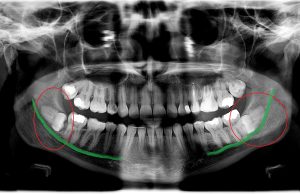Dental Monthly
Wisdom tooth extraction: The ultimate fright in the Dental chair


Now, is it always a nightmare?
No, of course not!
The operation can be fast and easy, and the post-op smooth with no suffering and fast healing.
What makes the difference?
A/The position of the wisdom tooth.
>Usually the uppers are easy to remove and are less prone to give you or the dentist any trouble during and after the extraction.
>So it is definitely the wisdom tooth in the lower jaw that has created “The Horror Legend”. This is because it may lay on its side in the very hard bone of the lower jaw, instead of sitting up straight, like the other teeth. And it may be half erupted, allowing dental plaque to infiltrate under the gums, and that creates decay and periodontal(gum) problems for both the wisdom tooth and its neighbouring molar.
B/The experience of the Dentist who performs the surgery is certainly very important.
>Many beginner’s errors, which badly affect the time (minutes or hours) required for this surgical extraction, will result in “Dry Socket”.
There might be difficulties with anesthetizing, problems with inadequate instruments or anatomical complications. Each of these factors could cause the operation to go on too long, meaning the patient might spend more than 2 hours with their mouth wide open, while a sweaty red-headed dentist pulls and pushes and hammers away. This will result in the worst post-op experience a patient could have, both physically and psychologically.
>An experienced dentist will prescribe and apply the required medication before and after surgery and will carefully study the operation site beforehand with a CB/CT scan. This three dimensional X-Ray reveals the shapes of the roots and any involvement of the big nerve in the lower jaw, so that surprises are avoided and he or she can work fast and efficiently with specific equipment.

C/The patient’s post operative behaviour.
>Smoking after an extraction, any extraction, reduces healing capacity by 50% and nearly always results in the dreaded “Dry Socket”.
>Rinsing after surgery or eating on the operated site disturbs or removes the blood clot, which is essential for the fast uneventful healing of the extraction site. This might cause post-op bleeding and/or “Dry Socket”.
Patients should leave the operated site alone and let their body do the job, leaving it in “Biological Peace” with no disturbance whatsoever, so that fast healing can occur.
Questions from the public:
1/ “Dry Socket” again and again…!!!
What is that?!?
- “Dry Socket” is the disastrous event of dried-up nude bone in the extraction site. As there is no blood clot to initiate healing, the post-operative healing will be very painful, slow and altered. Not to mention that the patient will have the worst breath ever. This situation needs specific treatment and may take up to 3 weeks.
2/OMG!!!… instead of being reassured, I am even more terrorised to remove MY POOR WISDOM TOOTH. I want to be WISE, so I will keep it. And that’s for sure!! … and I will never read your Dental Monthly again!!!!
- I am sorry about that…. but I like to be straightforward and truly inform you.
Anyway, if your wisdom tooth needs removing you really should have it done in order to avoid recurrent inflammation and abscesses from forming, which can be much worse than “Dry Socket”. Not removing it can cause Periodontal bone damage or deep cavities to the neighbouring teeth, and will compromise its health and future in your mouth.
To help you overcome your anxiety, at Studio Moll we use N2O sedation with a nose mask, which will make your time fly and reduce your awareness of what we are actually doing, while you stay completely conscious and alert.
3/Ok, you might have convinced me here, but please tell me… how do you treat this awful “Dry Socket”???
I mean I cannot leave my cigarettes alone, so with my luck I will probably develop the worst Dry Socket of your career…. ;((
- At Studio Moll our main focus is to PREVENT it, and we do this by working very quickly.
Our record of wisdom tooth removal is 3 minutes in the upper jaw and 15 to 20 minutes for a completely bone impacted wisdom tooth in the lower jaw. And that is real fast!
Furthermore, in patients who will probably heal slowly (the elderly, smokers like you), we place collagen sponges in the extraction site to catch and block the blood clot.
- The very few cases of post-operative “Dry Socket” we have seen, we have treated with with No Pain Laser sessions to recreate blood clots, which reduces the pain and altered healing.
I hope you are satisfied with my answers and maybe we will see you in my clinic for other treatments too😊)
For more inforomation, look up Studio Moll’s You Tube channel and here too.
By Dr. Elena Speranza Moll
Studio Moll
Via Amilcare Ponchielli 21B, 50018 Scandicci –Firenze
Tel: 055-755347
WhatsApp: 331-6362682
Follow me on Youtube

